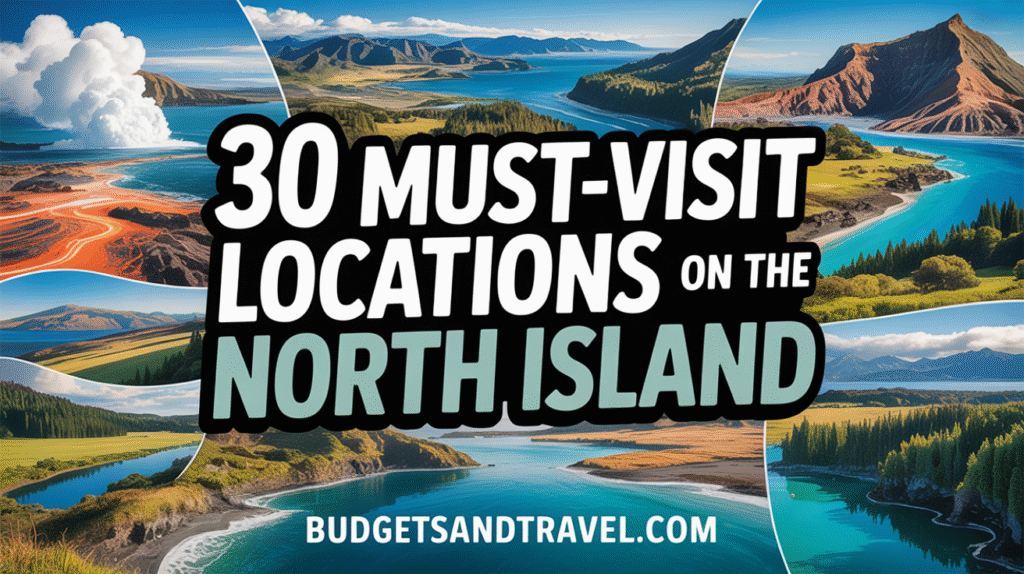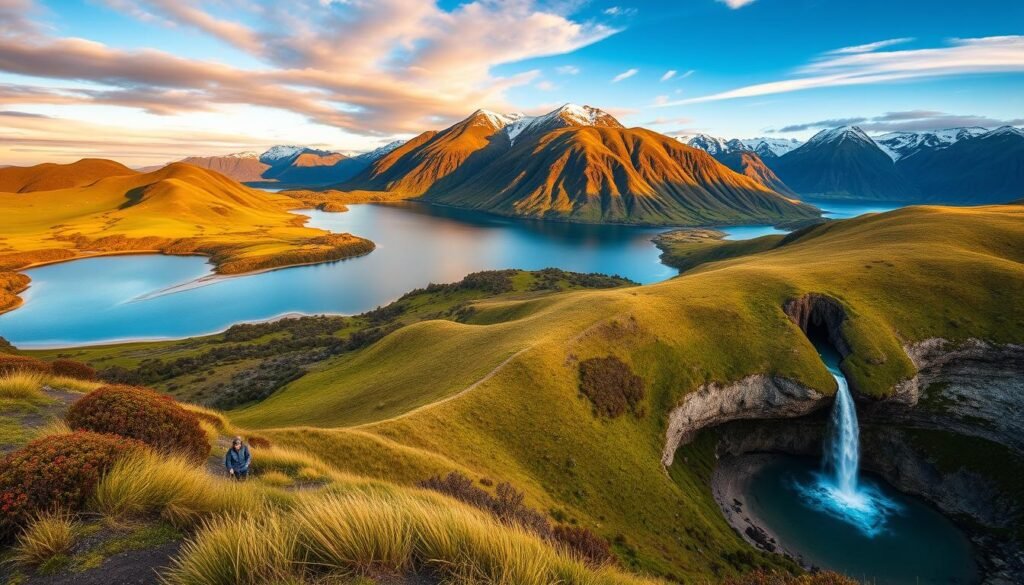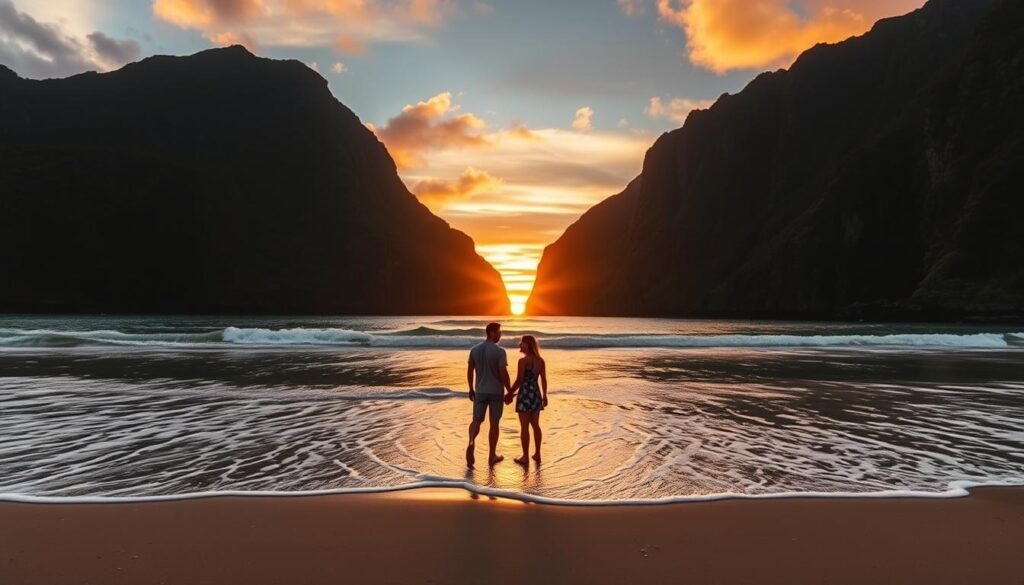New Zealand’s North Island is full of amazing places. Each spot offers something special, from nature’s wonders to cultural treasures. This guide will show you 30 places you must see. They will make your adventure exciting and unforgettable.
This post may contain affiliate links. If you make a purchase or booking through one of our links, we may earn a small commission. As an Amazon Associate, I earn from qualifying purchases. The content on this website was created with the help of AI.
From Auckland’s lively streets to Rotorua’s hot springs, you’ll find it all here. You’ll see famous sights, learn about Maori culture, and enjoy the island’s varied landscapes. It’s a top spot for travelers from around the world.
Planning Your North Island Adventure: Essential Travel Tips
Going on a North Island road trip or exploring New Zealand’s North Island is a memorable experience. To have the best trip, think about when to go, how to get around, and where to stay. Planning ahead makes your journey smooth and fun, as you see the area’s varied landscapes and sights.
Best Time to Visit the North Island
The North Island has a mild climate all year, attracting many visitors. But, some times are better than others, depending on what you like. Summer, from December to February, is great for warm days and outdoor fun. Spring and autumn offer nice weather and fewer people, letting you enjoy the natural beauty at your own speed.
Transportation Options
- Rental Cars: Renting a car lets you explore freely and find hidden spots easily.
- Public Transportation: Buses and trains are good for getting around, especially between big cities and popular spots.
- Domestic Flights: For long trips or saving time, flying within New Zealand is a good choice.
Accommodation Choices
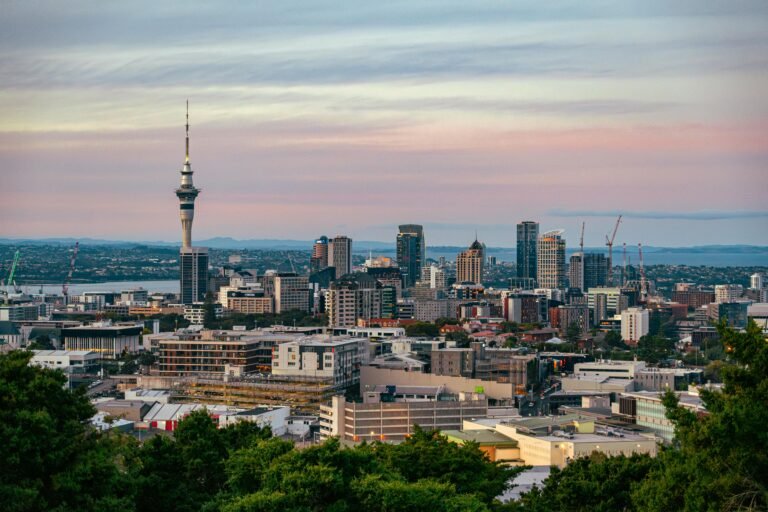
⏰ In a hurry?
👉 Tour we recommend in Auckland
👉 Where to stay in Auckland
💲 – Holiday Inn Express Auckland City Centre
💲💲 – voco Auckland City Centre
💲💲💲 – Mercure Auckland Queen Street
The North Island has many places to stay, from fancy resorts to affordable hostels. Whether you want peace, city life, or a family-friendly spot, there’s something for everyone. Book early, especially in busy times, to make sure you have a place.
With these travel tips, you’re ready for an amazing North Island adventure. You’ll see natural wonders, cultural spots, and stunning views at your own pace.
Exploring Auckland’s Urban Landmarks
Auckland, on the North Island, is a lively city full of iconic landmarks and varied neighborhoods. It’s a key top sights North Island spot, offering a mix of modern buildings, rich history, and beautiful harbor views.
The Sky Tower stands tall in Auckland’s skyline, giving visitors stunning 360-degree views. You can take a thrilling ride to the top deck. There, you can see the Hauraki Gulf and volcanic cones.
The Auckland Harbour Bridge is another must-see North Island spot. It connects the city’s north and south. You can walk or bike across for amazing harbor views. Or, join a tour to learn about its history and design.
The Auckland War Memorial Museum is a key place to learn about Auckland’s culture. It has a vast collection of Maori artifacts, art, and history. It gives a deep look into the region’s indigenous traditions and natural beauty.
| Top Sights in Auckland | Description |
|---|---|
| Sky Tower | Soaring 328 meters (1,076 feet) into the sky, this architectural marvel provides stunning 360-degree views of Auckland and the surrounding region. |
| Auckland Harbour Bridge | This iconic bridge connects the northern and southern shores of Auckland, offering visitors the opportunity to enjoy panoramic views of the harbor. |
| Auckland War Memorial Museum | This renowned museum showcases the rich history, culture, and natural wonders of New Zealand, with a focus on Maori heritage and artifacts. |
Exploring Auckland’s urban areas, you’ll find lively markets, top dining spots, and beautiful harbor views. These make Auckland a top sights North Island place to visit.
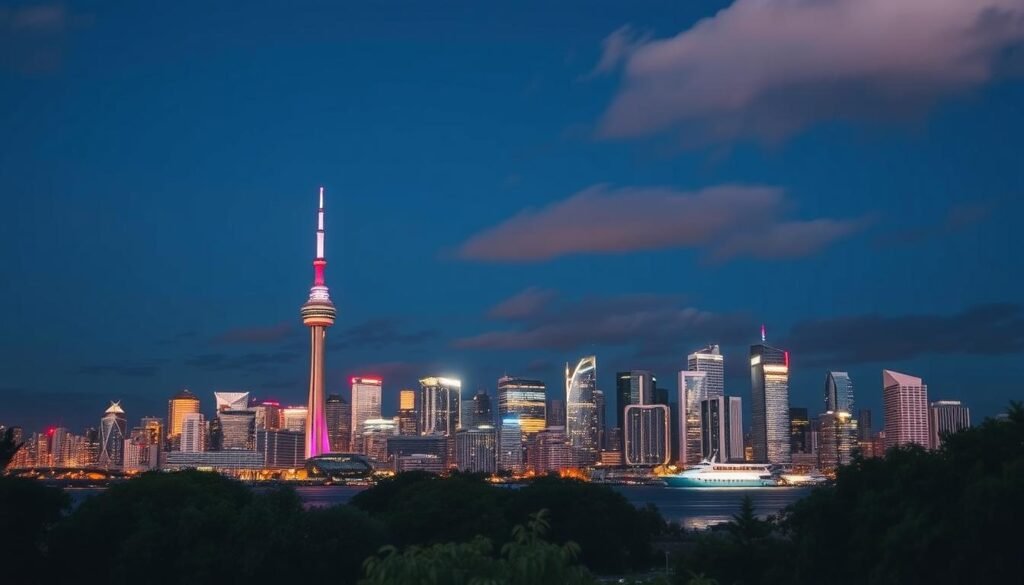
30 Must-Visit Locations on the North Island
Explore the North Island, New Zealand’s top travel spot. It stretches from the Bay of Islands in the north to Wellington in the south. This area is full of natural wonders, cultural spots, and hidden treasures. Our list of 30 places shows you the best of the North Island.
1. Auckland
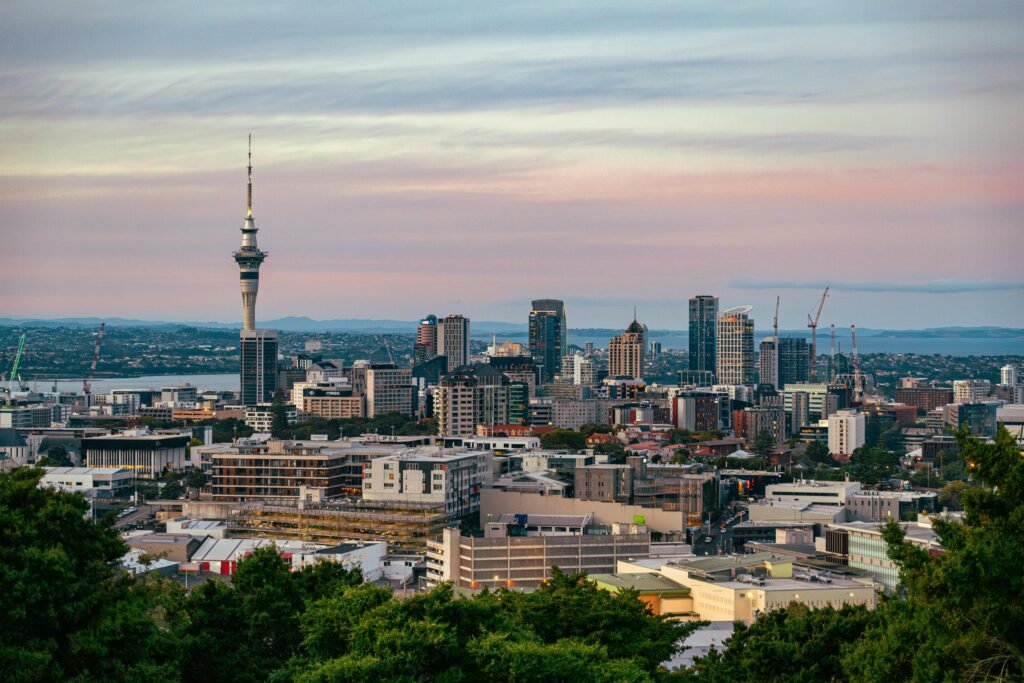
New Zealand’s largest city and gateway to the North Island, Auckland is a lively, multicultural hub flanked by two harbors and dotted with volcanic hills. It seamlessly blends city sophistication with outdoor adventure.
Why go:
For cosmopolitan energy, waterfront dining, scenic hikes, and easy access to island retreats.
What to expect:
Trendy neighborhoods like Ponsonby and Devonport, panoramic views from the Sky Tower, local food markets, and ferry access to nearby Waiheke or Rangitoto Islands.
Best time to visit:
Summer (December–February) offers warm, sunny weather and outdoor events; spring (October–November) and autumn (March) offer milder temps and fewer crowds.
Tip:
Take a walk up Mount Eden at sunrise for sweeping views of the city skyline, harbor, and volcano cones.
2. Waiheke Island
Less than an hour’s ferry ride from Auckland, Waiheke is a peaceful island escape famous for its vineyards, olive groves, golden beaches, and relaxed pace
What to expect:
Boutique wineries with sea views, bohemian markets, coastal walks, and fine dining perched above blue waters.
Why go:
For wine tasting, art galleries, boutique shopping, and scenic cycling or walking routes.
Best time to visit:
Late spring through early autumn (November–April) when vineyards are in bloom and vineyard tours are plentiful.
Tip:
Hire a bike or scooter to explore off-the-radar coves and vineyards at your own pace, and book tastings early on weekends in summer.
3. Piha Beach
A dramatic black‑sand surf beach on Auckland’s west coast, Piha is characterized by fierce Pacific waves and the iconic Lion Rock cliff—wild, rugged, and deeply scenic.
Why go:
For surfing, sunset views, wild coastal beauty, and a taste of New Zealand’s west‑coast surf culture.
What to expect:
Powerful surf, strong currents (swimming is for confident swimmers only), walking trails up Lion Rock, and rain‑forest fringes.
Best time to visit:
Summer (December–February) for surf and sunsets; avoid after heavy rain due to track erosion and rips in water currents.
Tip:
Don’t swim near Lion Rock—experts only. Catch the sunset from the headland parking area for dramatic views without the crowds.
4. Waitomo Caves
Located in rural Waikato, Waitomo Caves are a surreal subterranean world where glowworms light up limestone formations, offering both serene boat tours and adrenaline-fueled raft adventures.
Why go:
Because the glowworm grotto is like a natural galaxy, perfect for magic-seekers, nature lovers, and adventure junkies alike.
What to expect:
Guided boat rides under glowworm-lit ceilings, stalactite-filled chambers, and optional blackwater rafting through cave systems.
Best time to visit:
Year-round. Summer offers pleasant above-ground weather; winter visitors enjoy fewer crowds while caves maintain consistent conditions New Zealand.
Tip:
Book tours in advance during summer holidays to secure a spot, especially for the popular raft tours. Wear warm layers even in summer—it’s cooler underground.
5. Hobbiton Movie Set (Matamata)
Set within the rolling pastures of Matamata farmland, the Hobbiton Movie Set transports you into the shire from The Lord of the Rings and The Hobbit—a whimsical and beautifully detailed piece of Middle‑earth.
Why go:
Because fans and non‑fans alike delight in strolling hobbit holes, gardens, and thatched roofs, ending with a pint at the Green Dragon Inn.
What to expect:
Guided tours through lush pastures, perfectly manicured hobbit village, photo ops at iconic spots, and themed refreshments at the inn.
Best time to visit:
October–April; spring and autumn are ideal for gardens in bloom and pleasant temperatures. Summer can be busy but green and lush.
Tip:
Choose a sunrise or late afternoon “storybook” tour when the soft light and fewer crowds make the experience even more magical.
6. Rotorua
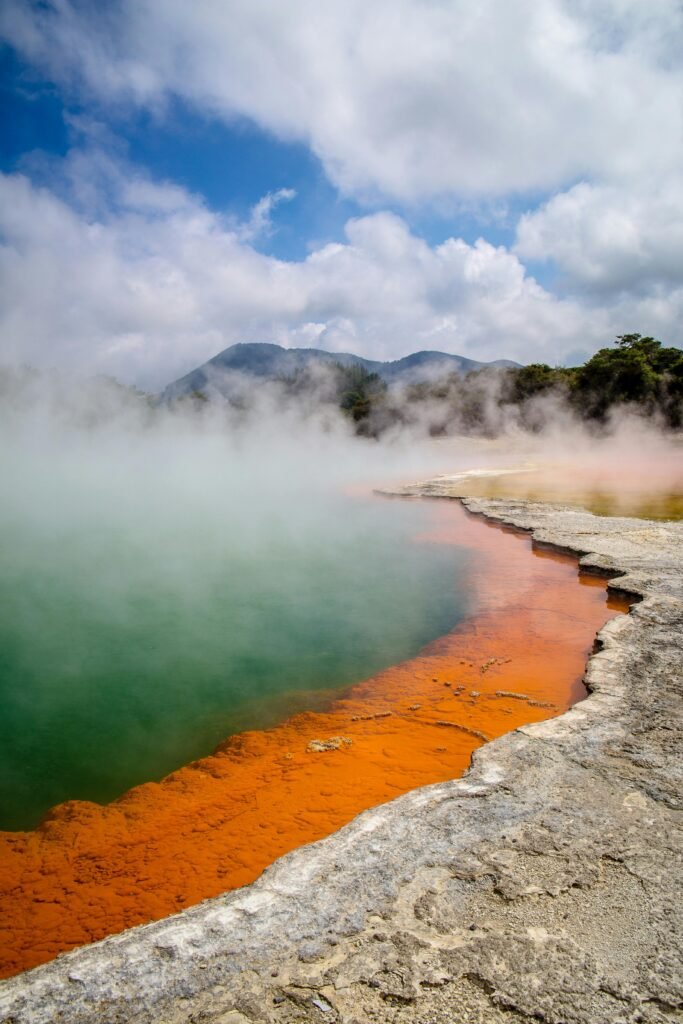
Nestled amid steaming geothermal fields and lakes, Rotorua is the heart of Māori culture and geothermal wonders. From spouting geysers and boiling mud pools to forest walks and cultural performances, it’s the perfect blend of adventure and culture.
Why go:
To experience geothermal phenomena paired with rich Māori traditions and restorative spa experiences.
What to expect:
Smoky fumaroles, acidic pools, forested trails, Māori cultural shows (haka, carving, weaving), and relaxing geothermal spas like Wai Ariki or the Polynesian Spa.
Best time to visit:
Late spring through early autumn (October–April), with November to March being the driest and warmest — though note that Rotorua summers can also bring rain.
Tip:
Visit either at sunrise or evening for a quieter, more magical experience. Popular attractions book up fast during summer, so reserve ahead; and don’t forget to try a mud spa at Hell’s Gate or Polynesian Spa for true relaxation.
7. Taupō (Lake Taupō Region)
Dominated by New Zealand’s largest freshwater lake, Taupō is the country’s adventure playground—boating, fishing, hiking, and geothermal parks blend against a backdrop of volcanic landscapes.
Why go:
It’s ideal for watersports, natural attractions like Huka Falls, and unique geothermal experiences like prawn farming.
What to expect:
Clear waters, jet boating, trout fishing, Huka Falls, spa baths, and quirky attractions like Huka Prawn Park where you can fish for prawns and ride aqua bikes over prawn ponds.
Best time to visit:
Summer (December–February) brings warm weather and full lakeside activity; shoulder seasons (March–April, October–November) offer pleasant weather with fewer visitors.
Tip:
Spend an afternoon at Huka Prawn Park for a fun and unusual geothermal aquaculture experience. Don’t miss free natural hot springs at Taupō’s Spa Park for a relaxing soak.
8. Tongariro Alpine Crossing (Tongariro National Park)
Located within Tongariro National Park—New Zealand’s oldest and a UNESCO World Heritage Site—this dramatic one-day hike crosses volcanic terrain, emerald lakes, and alpine desert with views of active volcanoes.
Why go:
It’s often hailed as one of the world’s best day hikes, blending natural beauty, geological marvels, and cultural significance.
What to expect:
Volcanic craters, emerald-colored lakes, sweeping alpine views, tussock plains, and windswept ridges. Many visitors choose guided tours for added insight and safety.
Best time to visit:
Optimal hiking season is October through April, with spring and autumn offering stable weather and fewer crowds. Snow and icy conditions suelen occur from June to August, making hikes challenging.
Tip:
Check weather forecasts and trail conditions before setting out—Nepal-style weather volatility is common. Respect Māori guidance: do not climb sacred summits like Mount Ngāuruhoe due to their spiritual significance.
9. Mount Maunganui (Tauranga)
A sunny coastal town known simply as “The Mount,” this beach destination offers surf, cafés, and a scenic summit hike overlooking the Pacific Ocean and Tauranga Harbour.
Why go:
For sun-soaked beaches, a relaxed seaside vibe, and the popular Mount summit walk with panoramic views.
What to expect:
Long sandy beaches perfect for swimming and surfing, bustling cafés, hot saltwater pools, and a rugged 326 m lava dome climb with rewarding vista views.
Best time to visit:
Summer (December–February) is perfect for beach activities and coastal cafes. Spring and autumn still bring pleasant weather with fewer crowds.
Tip:
Climb “The Mount” at sunrise – it’s a moderate hike with big payoff views. Afterwards, cool off with a swim or soak at nearby hot salt pools.
10. Coromandel Peninsula

The Coromandel Peninsula is rugged and picturesque, spotlighting golden beaches, native forests, and iconic coastal scenery at a relaxed pace that’s quintessential Kiwi.
Why go:
For pristine beach escapes, scenic coastlines, natural hot pools, and forested hikes.
What to expect:
Beautiful spots like Cathedral Cove and Hot Water Beach, towering kauri forests, coastal walkways, and local arts and crafts markets.
Best time to visit:
November through April is prime time—warm for bathing, good for digging hot pools at Hot Water Beach, and ideal for coastal hikes.
Tip:
At low tide at Hot Water Beach, bring a spade to dig your own thermal pool in the sand. To avoid parking struggles, arrive early, especially during summer weekends.
11. Whakatāne
A sun‑kissed seaside town in the Bay of Plenty, Whakatāne is a laid‑back hub that delivers beaches, Māori culture, and easy access to islands and conservation parks. It’s the perfect spot to unwind or launch outdoor adventures.
Why go:
For ocean views at Ōhope Beach, Māori cultural experiences, and a gateway to offshore islands and native forest reserves.
What to expect:
Golden sandy beaches, calm surf, kayaking or charter fishing, vibrant Māori festivals, and access to nearby natural attractions such as Whirinaki Forest.
Best time to visit:
Summer (December–February) with warm, sunny weather; spring and autumn (especially March–April and November) offer mild temperatures and fewer crowds.
Tip:
Spend a relaxed morning at Ōhope Beach, then hop on a guided eco-tour or charter fishing trip for dolphin or birdwatching as the afternoon breeze picks up.
12. Whanganui River Journey & National Park

Source: Department of Conservation (NZ)
The Whanganui River, New Zealand’s longest navigable waterway, flows through ancestral Māori lands and forested gorges to the city of Whanganui. Its multi‑day paddling route—the Whanganui Journey—is one of the nation’s iconic Great Walks.
Why go:
For a peaceful, immersive paddle through native forests and cultural landscapes, plus historic river communities and huts.
What to expect:
5-day canoe/kayak journey from Taumarunui to Pipiriki (or shorter variants), remote DOC huts and campsites, calm Class I–II rapids, lush native bush, and Māori settlement stops like Tīeke Kāinga and Jerusalem.
Best time to visit:
Great Walks season runs from October 1 to April 30, with late spring to early autumn (November–March) offering warm, stable weather ideal for paddling.
Tip:
Book your DOC hut or campsite in advance and secure a river Facilities User Pass. For calmer water and lighter crowds, avoid the busy school-holiday periods in January.
13. Taranaki / New Plymouth
Framed by the symmetrical cone of Mount Taranaki, the coastal region of New Plymouth offers dramatic coastal scenery, surf beaches, and an artsy city known for its gardens and galleries.
Why go:
To experience the scenic coastal walkway, surf-friendly beaches, and the cultural mix of nature and creativity with the backdrop of a majestic volcano.
What to expect:
Ocean-side boardwalks, volcanic summit trails, galleries and artisan food spots in New Plymouth, and occasional surf competition events in the region.
Best time to visit:
Summer and shoulder seasons (November–April) offer mild weather for walking and beach activities; winter brings rain and cooler temperatures, but fewer visitors.
Tip:
Stroll the New Plymouth Coastal Walkway any morning to snap Mt Taranaki mirrored in the surf. If you’re ambitious, tackle the Pouakai Crossing or Taranaki summit during dry weather.
14. Bay of Islands
Set in Northland, the Bay of Islands is a sparkling marine playground where history, Māori heritage, subtropical beaches, and island adventures converge.
Why go:
For yachting, dolphin spotting, the Waitangi Treaty Grounds, and a chain of 144 islands to explore by boat.
What to expect:
Boat tours between islands, beach escapes, kayaking, sailing, and a visit to the site where the Treaty of Waitangi was first signed.
Best time to visit:
Late spring to early autumn (November–March) brings warm sea conditions and clear skies; avoid mid‑January when locals travel. Spring and autumn offer lighter crowds.
Tip:
Take a half-day or full-day sailing or kayaking tour to explore offshore islands—and stop at the Treaty Grounds early in the morning to beat the tour-bus crowds.
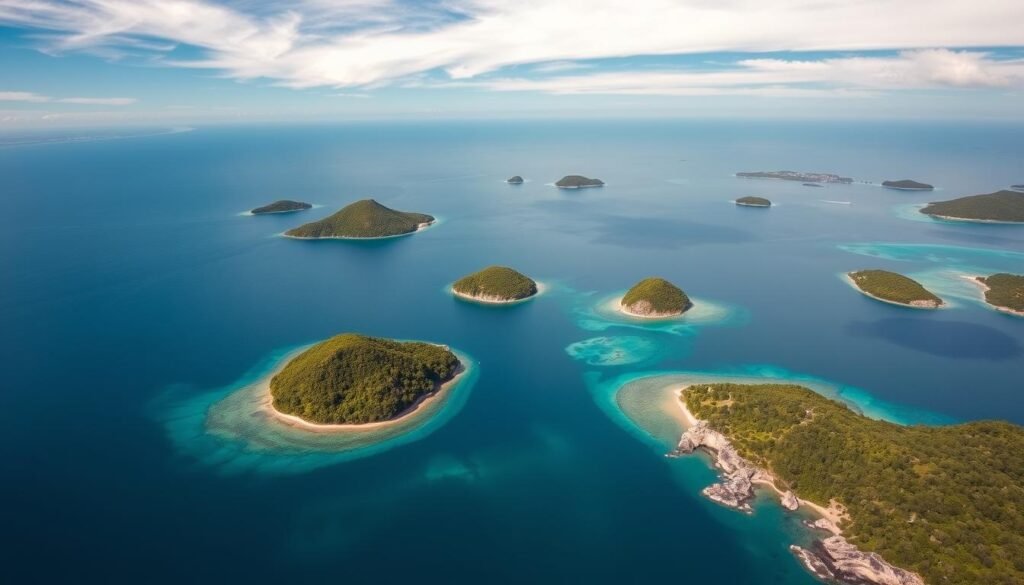
15. Russell (Bay of Islands)
Once New Zealand’s original European “capital,” Russell is a laid-back seaside village with historic charm, boutique lodgings, and a rich past nestled beside the Bay of Islands.
Why go:
For a step back in time amid well-preserved colonial architecture, marina views, and a relaxed coastal vibe.
What to expect:
Quiet waterfront eateries, boutique shops in heritage buildings, ferry views across Paihia, and peaceful seaside walks.
Best time to visit:
Late spring through early autumn (November–April) when the weather is warmest; autumn evenings can be pleasantly cool and crowd-free.
Tip:
Take the short ferry from Paihia for a scenic ride, then explore the town’s historic markers and enjoy fish and chips by the wharf at sunset.
16. Kerikeri
Located in the Bay of Islands region, Kerikeri is known for fruit orchards, historic mission sites, and lush waterfalls—with a small‑town charm shaped by heritage.
Why go:
To see New Zealand’s oldest stone building, botanical gardens, and taste fresh local fruit in a peaceful, scenic setting.
What to expect:
Historic sites like the Stone Store and Mission House, markets, nearby Rainbow Falls, walking trails, and seasonal produce stands.
Best time to visit:
Spring through late summer (October–March) when fruit is in season and gardens are in full bloom; mild in autumn as well.
Tip:
Visit on market day for fresh fruit, honey, or artisan products—then head to Rainbow Falls just outside town for a brief nature escape.
The Bay of Islands and Northland in New Zealand’s North Island is a true coastal paradise. It offers a mix of historic sites, exciting water activities, and stunning natural wonders. This area is a top spot for North Island attractions and New Zealand tourism.
17. Gisborne
At New Zealand’s eastern tip, Gisborne is the first city in the world to greet the sun. It blends surf culture, Māori heritage, wine, and beachside charm.
Why go:
For sunrise views over the Pacific, boutique wineries, world-class surf breaks, and relaxed coastal living.
What to expect:
Beach mornings, surf lessons or board rentals, vibrant local food and wine scene, and occasional Māori festivals.
Best time to visit:
Late spring to late summer (November–March) when temperatures are warm, days bright, and the sun rises earliest.
Tip:
Plan to catch 6:00 AM sunrise at Wainui Beach—then enjoy breakfast at one of the beachfront cafes and browse local vineyards by late morning.
18. Cape Reinga
Located at the northernmost tip of Aotearoa/New Zealand, Cape Reinga is where the Tasman Sea and Pacific Ocean meet. It’s a spiritual Māori landmark and offers sweeping coastal views from the lighthouse above sheer sand dunes.
Why go:
For dramatic landscapes, cultural significance (Te Rerenga Wairua, “leaping place of spirits”), and striking views over swirling seas.
What to expect:
Wind-swept headlands, a white lighthouse atop dramatic cliffs, nearby parallel dunes, and sacred Māori sites. Coastal walks and 90-Mile Beach are within easy reach.
Best time to visit:
Late spring through early autumn (October–April) when weather is mild and days are long. Winter can be very windy and stormy.
Tip:
Combine with a scenic drive along 90‑Mile Beach. Make sure to arrive late afternoon for softer light and quieter time at the cape.
19. Bay of Islands (overview)
A subtropical paradise in Northland, the Bay of Islands is a marine wonderland of 144 islands, historic towns, and cultural heritage—set against a backdrop of sparkling seas and lush forests.
Why go:
For boating, wildlife encounters, Māori history, and island hopping in a warm, tranquil setting.
What to expect:
Clear waters, dolphin and seal sightings, Waitangi Treaty Grounds, sailing, fishing, kayaking, and coastal walking tracks.
Best time to visit:
Late spring to early autumn (November–March) offers warm ocean conditions and long sunny days; shoulder seasons are a good balance of weather and fewer crowds.
Tip:
Book island cruises (e.g. “Hole in the Rock”) early in the morning to avoid wind and crowds. Visit Waitangi Treaty Grounds early to dodge tour bus rush.
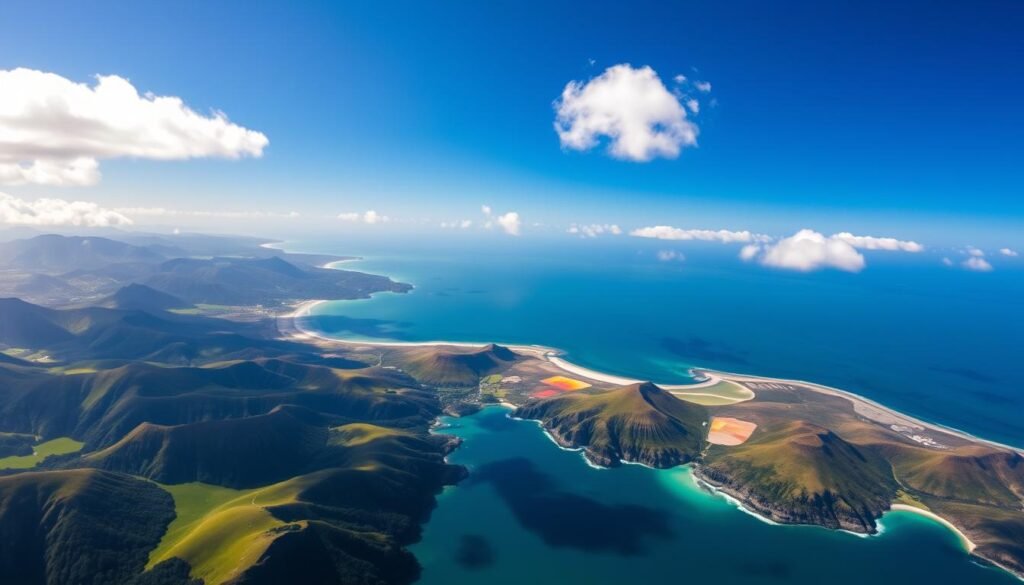
20. Russell (Bay of Islands)
Russell, perched on the Bay of Islands, is the first European settlement in New Zealand. Once known as Kororāreka, it now exudes colonial charm with serene wharfs, cafés, and historic architecture.
Why go:
For seaside serenity, are preserved colonial architecture, and café culture with marina views.
What to expect:
Historic streets, boutique shops, seaside restaurants, and ferry access to/from Paihia. Relaxed ambience with beach and marina views.
Best time to visit:
Late spring through early autumn (November–April) for warm, pleasant weather and relaxed evenings.
Tip:
Take the short ferry ride from Paihia for a picturesque arrival, then settle in with fish and chips by the wharf at sunset.
21. Kerikeri
As one of the Bay of Islands’ historic gems, Kerikeri is both horticultural hub and living museum—home to New Zealand’s oldest stone building, lush orchards, and cascading waterfalls.
Why go:
To walk among historic buildings, enjoy lush gardens, and sample the region’s fresh produce.
What to expect:
The Stone Store, Mission House, Kororipo Pā, town markets, local honey and fruit stalls, and nearby Rainbow Falls via a scenic walking trail.
Best time to visit:
Spring through late summer (October–March) when blossoms and orchards thrive and markets buzz with local produce.
Tip:
Visit on market day for fresh fruit and crafts, then head up the walking trail to Rainbow Falls just outside town for nature escape.
22. Gisborne
Situated on the easternmost edge of New Zealand, Gisborne is famed for being the first city to greet the sunrise. It blends strong Māori and surf culture with vineyards and a laid-back coastal ethos.
Why go:
For unforgettable sunrise views, local wine (especially chardonnays), surf beaches, and Māori festivals.
What to expect:
Beach mornings, surf breaks like Wainui, casual cafés, local vineyards, cultural events, and golden local produce.
Best time to visit:
Late spring through summer (November–March) when daylight is longest and sea breezes are inviting.
Tip:
Plan to catch sunrise at Wainui Beach (~6:00 AM), then grab breakfast nearby and leisurely explore local vineyards by mid‑morning.
23. Whanganui River Journey (National Park)
A unique Great Walk managed by DOC, the Whanganui Journey is a 145 km canoe or kayak paddle through native forest and Māori heritage sites, ending at the city of Whanganui. It’s the only Great Walk that travels by river.
Why go:
For a peaceful multi-day paddle through pristine landscapes and sacred Māori river corridor, with forested gorges and hidden history.
What to expect:
Five‑day paddling from Taumarunui to Pipiriki (or shorter options), DOC huts and campsites, calm rapids (Grade II), lush bush canopy, and cultural stops like Tīeke Kāinga and Bridge to Nowhere.
Best time to visit:
Great Walks season runs from late October to mid‑April. Though possible year-round, conditions outside this season (May–September) are colder, wetter, and facilities reduced.
Tip:
Book huts and campsites early via DOC. Even beginners with average fitness can navigate the route, but guided trips are advised for first-timers. Carry a distress beacon if travelling independently.
24. Hidden Gem Suggestion: Moutohorā (Whale Island) near Whakatāne
Just off Whakatāne’s coast, Moutohorā (Whale Island) is a predator-free sanctuary devoted to conservation and native wildlife. Guided day tours offer unique glimpses into New Zealand’s ecological restoration efforts.
Why go:
For sanctuary wildlife, snorkeling over vibrant reefs, and Māori storytelling in a restored native ecosystem.
What to expect:
Guided eco-tours, snorkelling with reef fish, guided bush walks, and insights into species reintroduction.
Best time to visit:
Late spring through summer (October–March) for calm seas and vibrant wildlife activity.
Tip:
Book with the Whakatāne Eco Tours in advance. Wear reef-safe sunscreen and bring snorkeling gear—or ask for rental.
25. Martinborough (Wairarapa wine region)
A charming heritage town in the Wairarapa, just east of Wellington, Martinborough has blossomed into a world-class wine region known for its boutique vineyards and relaxed pace.
Why go:
To taste exceptional Pinot Noir and Chardonnay in picturesque cellar doors you can walk or cycle between.
What to expect:
Over 20 small estates within walking distance of the town square, award-winning wineries like Ata Rangi, Palliser Estate, Te Kairanga and Schubert, plus a town café culture and local produce stands.
Best time to visit:
November to March—warm, sunny days make it ideal for alfresco tasting and walking between vineyards.
Tip:
Rent a bike or join a guided tasting tour to hit the top wineries along Puruatanga Road; don’t miss lunch at Poppies or Palliser Estate terraces.
26. Wellington (capital city)
Vibrant, cultural, and windy—Wellington punches well above its size with top-tier coffee, arts, food, and a compact harborfront. It’s perfect for exploring both city and nature in one stop.
Why go:
To enjoy New Zealand’s café and arts scene, iconic museums, and dramatic coastal views—all in one walkable city.
What to expect:
A thriving food-and-wine scene, Te Papa museum, film fans’ Wētā Workshop tours, lush Botanic Garden accessed via scenic cable-car, and nearby coastal paths like Red Rocks and Zealandia sanctuary.
Best time to visit:
Spring through autumn (September–April) for milder weather and fewer windy days—shoulder seasons bring crisp weekends and vibrant city life.
Tip:
Don’t rush through—stay at least two nights. Start with coffee at a boho café, hop the cable car, stroll the Botanic Garden, then wind down with a harbor-side pint or Weta Workshop visit.
27. Red Rocks Coastal Walk & Zealandia (on Wellington’s doorstep)
Just outside Wellington, two unique natural escapes lie within easy reach: the Red Rocks Coastal Walk wraps around volcanic outcrops and seal viewing cliffs, while Zealandia is a pioneering predator‑proof wildlife sanctuary within city limits.
Why go:
To blend rugged coastal hikes with wildlife spotting and conservation immersion—all without leaving the region.
What to expect:
At Red Rocks, sea-cliffs, basalt lava columns and fur seal sightings on a breezy shoreline trail; at Zealandia, native birds like tūī and kākā flit among restored forest inside an urban sanctuary.
Best time to visit:
Year-round, though spring and autumn offer mild temperatures and active wildlife.
Tip:
Bring layered clothing (wind can pick up on the coast), and pair the coastal walk with a mid-day visit to Zealandia to make the most of transports and differing habitats.
28. Kapiti Island Day Trip (from Wellington)
A predator-free bird sanctuary just off the Kapiti Coast, Kapiti Island is a hotspot for conservation and nature-lovers—accessible as a protected day trip from Wellington.
Why go:
To catch rare native bird species, bush-walk forest trails, and experience one of New Zealand’s premier wildlife reserves.
What to expect:
Guided eco tours with forest walks, birdwatching for species like kiwi and parakeets, and uninterrupted native bush habitat. Stoked to Travel
Best time to visit:
Spring to summer (September–March) when birdlife is most active and guided tours operate.
Tip:
Book through authorized operators from Wellington; permits are required and visitor numbers are strictly limited to protect the environment.
29. Huka Falls & geothermal highlights on the Taupō–Rotorua route
Between Rotorua and Taupō lies a geothermal wonderland—boiling mud pools, bubbling vents, and iconic waterfalls make this volcanic corridor unforgettable.
Why go:
For high-speed thrills at Huka Falls and the chance to explore geothermal attractions like Wai-O-Tapu or Hell’s Gate nearby.
What to expect:
Powerful turquoise waterfalls, adjacent hot springs and mud baths, geysers, and themed geothermal parks paired with vibrant Māori culture.
Best time to visit:
Year‑round: late spring through summer (November–March) is ideal, though geothermal conditions remain interesting even in cooler months.
Tip:
Arrive early to watch Huka Falls at its most vibrant; then cool off with a soak in Taupō’s free hot pools or book a private mud spa experience nearby.
30. Hidden gem: Aroha Island (Bay of Islands)
Aroha Island is a small, tranquil sanctuary island just off the Kerikeri Inlet—perfect for spotting the North Island kiwi in the wild within a protected setting.
Why go:
One of the few places where you can see the North Island brown kiwi in a managed reserve, alongside calm picnic spots and locally curated nature walks.
What to expect:
Serene walking trails through forested bird habitat, quiet waterside views, and occasional guided visits via causeway access.
Best time to visit:
Spring and early summer (October–December) for active wildlife and blooming edges.
Tip:
Pair with a stop in Kerikeri—markets, gardens and cafés—and make a reservation in advance, as access is controlled via island trust agreements.
New Zealand’s North Island isn’t just a destination — it’s a journey through geothermal wonders, Māori legends, golden coastlines, vineyard valleys, and volcanic peaks. Whether you’re soaking in a hot spring under the stars, kayaking down a sacred river, tasting Pinot Noir in a boutique cellar, or catching the sunrise from the edge of the world — this island delivers unforgettable moments at every turn.
What makes the North Island so special is its balance of wild beauty and deep culture. It’s where you can chase waterfalls one day and sip world-class wine the next. It’s for the thrill-seekers, the road trippers, the beach lovers, the storytellers, and anyone who wants to feel something deeper than just a view.
So whether you’re planning a whirlwind week or a month-long adventure, these 30 incredible spots are the perfect starting point. Mix the famous highlights with hidden gems, and you’ll come home with a travel story that’s all your own.

